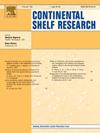Experimental warming effects on microbial community growth and mortality during the cold season in coastal waters of Taiwan and Japan
IF 2.2
3区 地球科学
Q2 OCEANOGRAPHY
引用次数: 0
Abstract
We conducted three in situ microcosm experiments in Taiwan and Japan during the winter of 2023 to investigate microbial plankton community responses to warming in Pacific coastal waters. Monitoring and analyzing microbial communities, including viruses, bacteria, and picophytoplankton (Synechococcus spp., Prochlorococcus spp., and picoeukaryotes), were performed by flow cytometry over seven consecutive days. Control microcosms were maintained at ambient coastal water temperature, while experimental microcosms were warmed by + 2–3°C. The modified dilution method estimated picoplankton (heterotrophic bacteria and picophytoplankton) growth, grazing, and viral lysis rates on days two and five. Our time-series incubation experiments revealed that warming did not increase bacterial abundance, but viral abundance significantly increased with temperature, indicating a strong lytic impact on bacteria. Moreover, the relative increase in viral abundance was related to a rise in Synechococcus spp. abundance under warming conditions across all study sites, relative to ambient conditions. Similar trends were observed in nanoflagellate abundance between the two treatments across all stations. In modified dilution experiments, viral lysis accounted for up to 51% of picoplankton mortality, compared to total mortality, indicating that viral lysis was the primary driver of picoplankton mortality under warmed conditions. These findings highlight the critical role of viruses in cold marine environments and suggest the potential for modeling viral functions to predict the effects of global warming on microbial dynamics.
台湾和日本沿海寒季暖化对微生物群落生长和死亡率的实验效应
我们于2023年冬季在台湾和日本进行了三次原位微观实验,研究了太平洋沿海水域浮游微生物群落对变暖的响应。用流式细胞术连续7天监测和分析微生物群落,包括病毒、细菌和浮游植物(聚藻球菌、原绿球藻和微真核生物)。对照微环境保持在沿海环境水温,而实验微环境加热+ 2-3°C。改良的稀释法估计了第2天和第5天浮游生物(异养细菌和浮游植物)的生长、放牧和病毒裂解率。我们的时间序列孵育实验表明,升温没有增加细菌丰度,但病毒丰度随着温度的升高而显著增加,表明对细菌有很强的裂解作用。此外,与环境条件相比,在所有研究地点的变暖条件下,病毒丰度的相对增加与聚球菌丰度的增加有关。在所有站点的两种处理之间,观察到纳米鞭毛虫丰度的类似趋势。在改良稀释实验中,与总死亡率相比,病毒裂解占浮游生物死亡率的51%,这表明病毒裂解是温暖条件下浮游生物死亡的主要驱动因素。这些发现强调了病毒在寒冷海洋环境中的关键作用,并提出了模拟病毒功能以预测全球变暖对微生物动力学影响的潜力。
本文章由计算机程序翻译,如有差异,请以英文原文为准。
求助全文
约1分钟内获得全文
求助全文
来源期刊

Continental Shelf Research
地学-海洋学
CiteScore
4.30
自引率
4.30%
发文量
136
审稿时长
6.1 months
期刊介绍:
Continental Shelf Research publishes articles dealing with the biological, chemical, geological and physical oceanography of the shallow marine environment, from coastal and estuarine waters out to the shelf break. The continental shelf is a critical environment within the land-ocean continuum, and many processes, functions and problems in the continental shelf are driven by terrestrial inputs transported through the rivers and estuaries to the coastal and continental shelf areas. Manuscripts that deal with these topics must make a clear link to the continental shelf. Examples of research areas include:
Physical sedimentology and geomorphology
Geochemistry of the coastal ocean (inorganic and organic)
Marine environment and anthropogenic effects
Interaction of physical dynamics with natural and manmade shoreline features
Benthic, phytoplankton and zooplankton ecology
Coastal water and sediment quality, and ecosystem health
Benthic-pelagic coupling (physical and biogeochemical)
Interactions between physical dynamics (waves, currents, mixing, etc.) and biogeochemical cycles
Estuarine, coastal and shelf sea modelling and process studies.
 求助内容:
求助内容: 应助结果提醒方式:
应助结果提醒方式:


